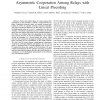Free Online Productivity Tools
i2Speak
i2Symbol
i2OCR
iTex2Img
iWeb2Print
iWeb2Shot
i2Type
iPdf2Split
iPdf2Merge
i2Bopomofo
i2Arabic
i2Style
i2Image
i2PDF
iLatex2Rtf
Sci2ools
GLOBECOM
2007
IEEE
2007
IEEE
Asymmetric Cooperation Among Relays with Linear Precoding
— Fixed and mobile relays are used, among other applications, in the downlink of cellular communications systems. Cooperation between relays can greatly increase their benefits in terms of extended coverage, increased reliability, and improved spectral efficiency. In this paper, we introduce the fundamental notion of asymmetric cooperation. For this, we consider a two-phase transmission protocol where, in the first phase, the base station (BS) sends several available messages to the relays over wireless links. But, depending on the channel state and the duration of the BS transmission, not all relays decode all messages. In a second phase, the relays, which may now have asymmetric message knowledge, use cooperative linear precoding for the transmission to the mobile stations. We show that for many channel configurations, asymmetric cooperation, although (slighlty) sub-optimum for the second phase, is optimum from a total-throughput point of view, as it requires less time and ener...
| Added | 02 Jun 2010 |
| Updated | 02 Jun 2010 |
| Type | Conference |
| Year | 2007 |
| Where | GLOBECOM |
| Authors | Natasha Devroye, Neelesh B. Mehta, Andreas F. Molisch |
Comments (0)

